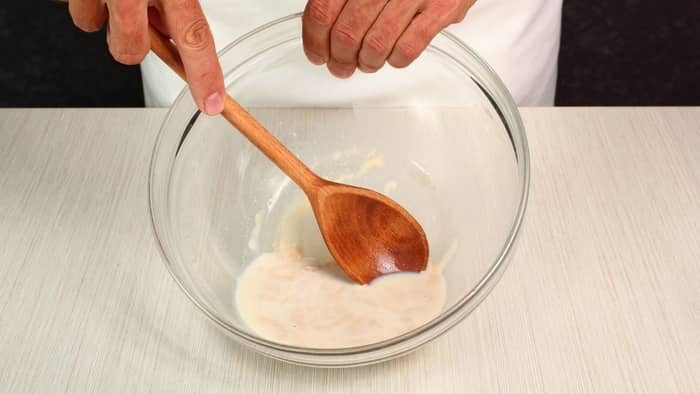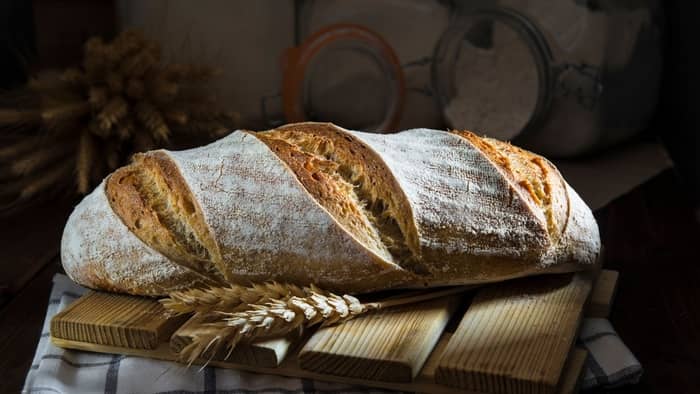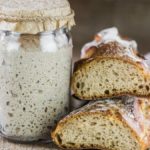Last Updated on January 2, 2023
Did you know that you can add yeast to sourdough starter? Here’s how you can make a quick pre-ferment at home for tangy sourdough bread!
Sourdough starters are incredibly delicious and flavorful pre-ferments that help add a tangy flavor and open chewy crumb. However, making these can be quite time-consuming. Luckily, we have developed a quick and effective starter recipe that will be ready to use in only 5 days!
What Is A Sourdough Starter?
A sourdough starter also referred to as a levain, is a type of pre-ferment used in bread-making. Pre-ferments are used as a unique leavening agent in bread. It also adds flavor and an interesting texture to the crumb of the loaf.
A sourdough starter specifically is made using flour and water. This mixture ferments using the natural yeast present in the flour.
Every day, the starter is fed with more flour to help keep it alive and growing. The longer the yeast is alive (the older the starter is) the better the flavor gets and the better texture it will give the bread.
Once the pre-ferment is fully developed (usually after about 7 to 12 days depending on the environment) it is used in a sourdough bread recipe. It functions as a leavening and flavoring ingredient.
Yeast in sourdough starters
Now, let’s look at the yeast part of sourdough starters. Some pre-ferments do contain a portion of or all of the yeast required in the bread recipe.
While a traditional starter can be made using only flour and water, some people like adding dry yeast or instant yeast to their starters.
In a starter, it helps give the pre-ferment a “head-start” and that bit of extra fermentation activity. Essentially, it helps you create a cheat starter. You don’t have to wait as long for the fermentation process to start and can use it within a day or two.
Anchor Hocking Glass Mixing Bowls, Mixed, Set of 10
Yeast in Sourdough Bread Recipes
Yeast is also sometimes added in addition to the sourdough starter. This does the same as it would for a starter. It gives the dough an added boost and will make the loaf rise more.
Adding yeast to the bread recipe isn’t very common and you are far more likely to add it to the starter itself.
Can You Add Yeast After The Dough Is Mixed?
You can add yeast to the dough after it has been mixed. However, we wouldn’t recommend it.
First, if your dough did not rise as much as you wanted, it is never going to make as good bread as you wanted. So, in our opinion, don’t bother. Rather start the dough from scratch and make the bread with a little bit more yeast.
The additional yeast will also not work as effectively when added in after the dough has been made. The dough is already quite heavy and the yeast won’t be able to create a massive lift.
But, if you really do want to add some extra yeast after the dough has been made, here’s how.
Regardless of whether or not you are using dry or fresh yeast, you will need to dissolve and activate it in some lukewarm water. It will be much easier to incorporate into the dough once it has been dissolved in water.
To control the consistency of the dough, you can adjust the amount of water you are dissolving the yeast in. So, if for example, you don’t need a lot of water (because you don’t want a very wet dough), then only dissolve the yeast in a little. But, if you have an extremely stiff dough that needs a lot of hydration, you can dissolve it in much more water.
The exact amount of yeast you will need to use is entirely relative. We would say start with 5 grams. But, again, we highly recommend just starting a new dough from scratch. You can use the “bad” dough to make cheat flatbread instead.
1) What You Will Need To Make This Sourdough Starter Recipe With Yeast
Ingredients
- 5 grams of active dry yeast
- 1 cup lukewarm water
- 1 cup bread flour
Equipment
- Medium glass mixing bowl
- Large glass mixing bowl
- Wooden spoon
- Rubber or silicone spatula
- Large glass jar or container
- Cheesecloth
- Rubber band or string
Step-by-step instructions
Step 1: Activate the yeast
In a medium mixing bowl, combine the active dry yeast and the lukewarm water. Do not heat the water too much as it will kill the yeast. Mix the ingredients with a wooden spoon until all of the yeast has dissolved.
Step 2: Add the yeast to the flour
Next, add bread flour into a large glass mixing bowl. Add the yeasty water mixture to the flour. Combine the ingredients using a wooden spoon.
You can continue mixing until you have a smooth batter-like mixture.
Step 3: Store the starter
Pour your quick sourdough starter into a large glass container that is at least 4 or 5 times bigger than your starter. The starter should have more than enough space to grow.
Cover the top of the container with 2 layers of cheesecloth and secure it with a rubber band or string.

Storing Your Sourdough Starter
You can either keep your sourdough starter in a warm spot or inside the refrigerator. The fridge will slow the growth of the starter. This means you won’t have to feed it as often to keep it alive.
But, as we have mentioned, you can store it at room temperature. Just make sure you keep it away from any extreme temperatures (like the oven) and away from direct light.
When the starter is stored at room temperature, it should be fed at least once a day. This will keep it healthy and ensure it doesn’t die.
2) How To Feed Your Sourdough Starter With Yeast – Every Day
Ingredients
- 1 cup starter
- 1 cup (110 grams) bread flour
- 1/2 cup lukewarm water
Equipment
- Large glass mixing bowl
- Wooden spoon
- Rubber or silicone spatula
- Large glass jar or container
- Cheesecloth
- Rubber band or string
Step 1: Measure Out Your Starter
You only need about 1 cup of starter. Whatever remains can be used to make a loaf of sourdough or other baked goods. You can also discard whatever you don’t use, especially if you aren’t baking anything at the time.
Add the starter to a clean glass bowl.
Step 2: Add the Flour and Water
Next, add 1 cup of bread flour and 1/2 cup of lukewarm water to the sourdough starter. Gently mix them together until you have a smooth mixture.
Step 3: Store Your Fed Starter
Finally, place the now-fed starter back into the cleaned glass jar and store it as previously instructed.
Tips And Tricks On How To Add Yeast To Sourdough Starter
- First and foremost, this quick sourdough starter recipe with yeast will be ready to use after 5 days (when kept at room temperature). Much quicker compared to a flour-water-only starter that could take up to 2 weeks to properly develop!
- We highly recommend only using clean glass containers. This will ensure your starter (which is very porous) doesn’t absorb any off colors and flavors from stained plastic bowls.
- Do not forget to feed your starter. If you cannot do so every day, store it in the fridge so that it grows at a much slower pace.
- This sourdough starter recipe with yeast also freezes very well. Freezing will essentially inhibit all growth without killing the bacteria.
- Whichever flour you started the initial ferment with, keep using it to feed your starter. Changing flours will change the flavor and characteristics of the starter itself and the sourdough you are making.
Servings and Preparation Time
| Prep time | Time until ready to use | Makes |
| 5 minutes | 5 days | 3-4 cups per day |
How Long Does Bread Need To Rise With Instant Yeast?
Instant yeast is fantastic if you’re looking for bread that’s quick and easy. Before you use the instant yeast, it’s recommended to leave it at room temperature for around 15 minutes. At this point, your instant yeast should have a layer of foam on top and this is a sign that your yeast is active and ready to use. Bread that uses instant yeast needs far less time to prove. A loaf of this bread should only need around 30-45 minutes to prove; it may need slightly longer if it’s not proven in a relatively warm area.
How Many Packets of Yeast To Make Bread?
The amount of yeast you use for your bread will all come down to how much flour the recipe calls for. Let’s take a look at some examples.
- For every 4 cups of flour in your recipe, you’ll need 1 packet of active dry yeast.
- For every 4-8 cups of flour, you’ll need 2 packets of active dry yeast.
- For every 8-12 cups of flour, you’ll need 3 packets of active dry yeast.
- For every 12-16 cups of flour, you’ll need 4 packets of active dry yeast.
- For every 16-20 cups of flour, you’ll need 5 packets of active dry yeast.
Be sure to change the amounts of packets you use, as to how much flour your recipe asks for. If your recipe only has 2 cups of flour, you’d only need half of one packet.
Where Did Yeast Bread Originate?
Yeast has been used as the main ingredient in bread for thousands of years. While there is no definitive time frame, the earliest recordings of yeast bread were in China and Ancient Egypt. For Egypt, it was as far back as 1500 BCE and for China, it was between 500-300 BC.
While we can’t know for sure, it’s said that flour and water were mixed and accidentally left out on a hot day, and the yeast that naturally comes from flour had fermented and caused the bread to rise, as well as being lighter than their typical bread. They then would have consciously used yeast products to improve their bread. Over the years, it has evolved and it’s now much quicker to rise, as well as being easily accessible and affordable too.
What Can I Make With Yeast Other Than Bread?
While a loaf of bread is the most common way to use yeast, there are plenty of other foods you can make using yeast, as well as using it for other aspects of life too. For other foods, you can use making yeast, and you can make desserts such as beignets, cinnamon rolls, and chocolate and cherry stromboli. As well as this, you can make less traditional bread products like breadsticks or tomato focaccia. Other popular foods include pizza, either deep dish or thin crust, sticky buns, and even pretzels!
For uses outside of food, it’s thought that yeast is great at refreshing your skin and giving your hair a glossy shine. It can also make good use in your garden too, it’s good for your compost, as well as controlling any slug problems you may have.
What is the Best Flour to Feed Sourdough Starter?
When it comes to feeding your sourdough starter with flour, there’s a huge selection of flours you can use. However, I find the best results come from using any type of wheat flour. The most popular options to use (and the most affordable) are either whole wheat flour or all-purpose flour. You can also use flours such as spelt or rye, but these flours aren’t quite as common.
What’s a Sourdough Starter Called?
While it’s usually called a sourdough starter, you may know it better by its traditional name, levain. Levain is a type of fermented dough. The levain is what eventually makes your sourdough bread rise, instead of ingredients such as yeast. Some people believe that it also has a better texture and flavor than bread that uses yeast, too.
How Long Can You Go Without Feeding Your Sourdough Starter?
At room temperature, sourdough starter needs feeding every day, which simply just isn’t realistic. This is why it’s best to keep the sourdough starter in the refrigerator. If you don’t plan on using your sourdough starter anytime soon, it can typically last around two months without feeding. If not, you should be feeding your starter around once a week.
If you have left your sourdough starter without being fed for around two months, you’ll need to remove it from the fridge around 36 hours before you intend to use it. You should then feed it every 12 hours so that it has time to act again. It should then be perfectly okay to use for your sourdough bread!
Final Words
As you can now see, it is incredibly easy to add yeast to a sourdough starter. It will allow you to get baking in no time and still have deliciously tangy bread! If you know of anyone wanting to get into making sourdough, share this article to help get them starter!
How To Add Yeast To Sourdough Starter and Maintain It
Equipment
- Medium glass mixing bowl
- Large glass mixing bowl
- Rubber or silicone spatula
- Large glass jar or container
- Cheesecloth
- Rubber band or string
Ingredients
- 5 grams active dry yeast
- 1 cup lukewarm water
- 1 cup bread flour
Instructions
- Activate the yeast. In a medium mixing bowl, combine the active dry yeast and the lukewarm water. Do not heat the water too much as it will kill the yeast. Mix the ingredients with a wooden spoon until all of the yeast has dissolved.5 grams active dry yeast, 1 cup lukewarm water
- Add the yeast to the flour.Next, add bread flour into a large glass mixing bowl. Add the yeasty water mixture to the flour. Combine the ingredients using a wooden spoon.You can continue mixing until you have a smooth batter-like mixture.1 cup bread flour
- Store the starter.Pour your quick sourdough starter into a large glass container that is at least 4 or 5 times bigger than your starter. The starter should have more than enough space to grow.Cover the top of the container with 2 layers of cheesecloth and secure it with a rubber band or string.

Lindy Van Schalkwyk is a culinary specialist with a background in Advanced Cooking, Advanced Pâtisserie, Media Communications and Nutrition. She has gained invaluable experience in the culinary industry having worked in some of the top restaurants in Africa in 2016 and 2017. Her expertise in nutrition has enabled her to develop recipes for special dietary needs. In 2018, Lindy began working in the Food Media industry, focusing on recipe development, recipe writing, food writing and food styling.




